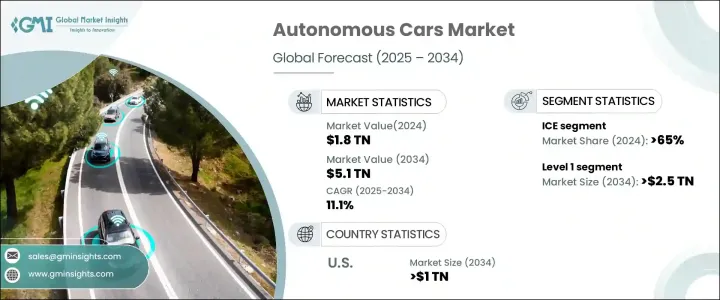PUBLISHER: Global Market Insights Inc. | PRODUCT CODE: 1685157

PUBLISHER: Global Market Insights Inc. | PRODUCT CODE: 1685157
Autonomous Cars Market Opportunity, Growth Drivers, Industry Trend Analysis, and Forecast 2025 - 2034
The Global Autonomous Cars Market reached USD 1.8 trillion by 2024 and is anticipated to grow at a CAGR of 11.1% through 2034. This surge is primarily driven by breakthroughs in artificial intelligence (AI) and machine learning, which are enhancing vehicle autonomy. Recent advancements in sensor technologies, such as LiDAR and cameras, have enabled vehicles to interact with their surroundings more reliably, leading to increased consumer confidence in adopting autonomous vehicles. These technological improvements are not only transforming vehicle capabilities but also improving real-time decision-making, which bolsters safety and optimizes routing efficiency. As the demand for connected and autonomous vehicles rises, these technologies are becoming essential to meet the growing consumer interest and expectations.

Another factor contributing to market expansion is the growing emphasis on traffic safety. Autonomous vehicles aim to reduce human error, which is responsible for a significant number of road accidents. The implementation of automated safety systems such as collision detection, adaptive cruise control, and automatic braking enhances safety and accelerates the market's growth. Governments and industry bodies are supporting the development and deployment of these systems through favorable regulations, further fueling market expansion. As autonomous technologies continue to evolve, they are expected to make an even greater impact on road safety and efficiency.
| Market Scope | |
|---|---|
| Start Year | 2024 |
| Forecast Year | 2025-2034 |
| Start Value | |
Table of Contents
Chapter 1 Methodology & Scope
- 1.1 Research design
- 1.1.1 Research approach
- 1.1.2 Data collection methods
- 1.2 Base estimates and calculations
- 1.2.1 Base year calculation
- 1.2.2 Key trends for market estimates
- 1.3 Forecast model
- 1.4 Primary research & validation
Chapter 2 Executive Summary
Chapter 3 Industry Insights
Chapter 4 Competitive Landscape, 2024
Chapter 5 Market Estimates & Forecast, By Autonomy, 2021 - 2034 ($Bn, Units)
Chapter 6 Market Estimates & Forecast, By Fuel, 2021 - 2034 ($Bn, Units)
Chapter 7 Market Estimates & Forecast, By End Use, 2021 - 2034 ($Bn, Units)
Chapter 8 Market Estimates & Forecast, By Region, 2021 - 2034 ($Bn, Units)
Chapter 9 Company Profiles




